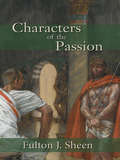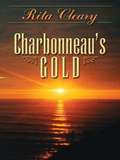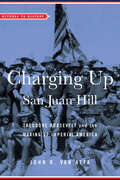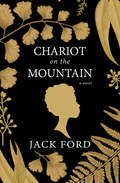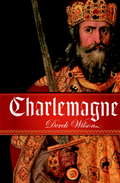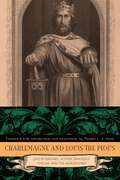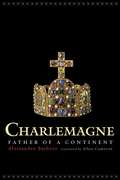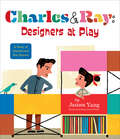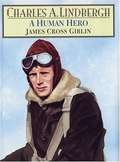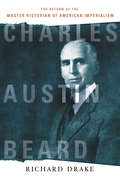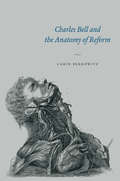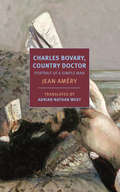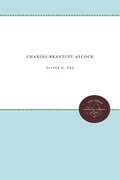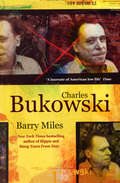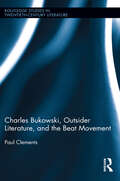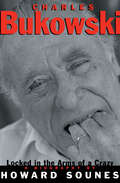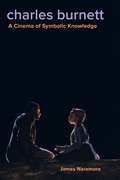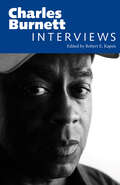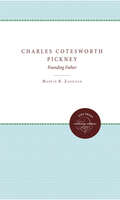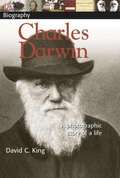- Table View
- List View
Characters of the Passion
by Fulton J. Sheen James TissotTo give us a better understanding of the Catholic Faith, in Characters of the Passion Fulton J. Sheen returns us to Calvary. There he dramatically brings to life in brief but penetrating characterizations many who played important roles in the "Eternal Drama of the Cross." Peter, Judas, Pilate, Herod, Barabbas, and others make an appearance, and through them the author shows us new aspects of the glory of the Faith. Fulton Sheen was unparalleled in his ability to combine theology, devotion, and the profoundest meditations on the central events of the Christian narrative. His writing is a message of inspiration to all: to those wavering in their beliefs he brings comfort and strength; to others he affirms the knowledge that true faith is the most powerful weapon in the world today, ever-ready to meet the challenges of modern life.
Charbonneau's Gold: A Lewis & Clark Story
by Rita ClearyThe hardships were incredible. The duration of the trip overland and over the Rockies was much longer than expected. Some hope arrived with Charbonneau, who claimed he knew the way to the Pacific
Charging Up San Juan Hill: Theodore Roosevelt and the Making of Imperial America (Witness to History)
by John R. Van Atta“Sheds new light on the history of Theodore Roosevelt and the legendary exploits of his illustrious ‘cowboy’ regiment?the Rough Riders.” —Bonnie M. Miller, author of From Liberation to ConquestAt the turn of the twentieth century, Theodore Roosevelt personified American confidence. A New York City native and recovered asthmatic who spent his twenties in the wilds of the Dakota Territory, Roosevelt leapt into Spanish American War with gusto. He organized a band of cavalry volunteers he called the Rough Riders and, on July 1, 1898, took part in their charge up a Cuban hill the newspapers called San Juan, launching him to national prominence. Without San Juan, Van Atta argues, Roosevelt—whom the papers credited for the victory and lauded as a paragon of manhood—would never have reached a position to become president.In Charging Up San Juan Hill, John R. Van Atta recounts that pivotal assault by Roosevelt and the Rough Riders. Describing the battle’s background and its ramifications for Roosevelt, both personal and political, Van Atta explains how Roosevelt’s wartime experience prompted him to champion American involvement in world affairs. Tracking Roosevelt’s rise to the presidency, this book argues that the global expansion of American influence—indeed, the building of an empire outward from a strengthened core of shared values at home—connected to the broader question of cultural sustainability as much as it did to the increasing of trade, political power, and military might.“Van Atta adeptly links Roosevelt’s deep immersion in Western American culture to his investment in American imperialism in a readable cultural and military history . . . a worthy addition to the shelves of Western historians.” —Western Historical Quarterly
Charging Up San Juan Hill: Theodore Roosevelt and the Making of Imperial America (Witness to History)
by John R. van Van AttaHow Theodore Roosevelt and his Rough Riders exemplified "manhood" and civic virtue.Below a Cuban sun so hot it stung their eyes, American troops hunkered low at the base of Kettle Hill. Spanish bullets zipped overhead, while enemy artillery shells landed all around them. Driving Spanish forces from the high ground would mean gaining control of Santiago, Cuba, and, soon enough, American victory in the Spanish-American War. No one doubted that enemy fire would claim a heavy toll, but these unusual citizen-soldiers and their unlikely commander—39-year-old Colonel Theodore Roosevelt—had volunteered for exactly this kind of mission.In Charging Up San Juan Hill, John R. Van Atta recounts that fateful day in 1898. Describing the battle’s background and its ramifications for Roosevelt, both personal and political, Van Atta explains how Roosevelt’s wartime experience prompted him to champion American involvement in world affairs. Tracking Roosevelt’s rise to the presidency, this book argues that the global expansion of American influence—indeed, the building of an empire outward from a strengthened core of shared values at home—connected to the broader question of cultural sustainability as much as it did to the increasing of trade, political power, and military might.At the turn of the twentieth century, Theodore Roosevelt personified American confidence. A New York City native and recovered asthmatic who spent his twenties in the wilds of the Dakota Territory, Roosevelt leapt into the war with Spain with gusto. He organized a band of cavalry volunteers he called the Rough Riders and, on July 1, 1898, took part in their charge up a Cuban hill the newspapers called San Juan, launching him to national prominence. Without San Juan, Van Atta argues, Roosevelt—whom the papers credited for the victory and lauded as a paragon of manhood—would never have reached a position to become president.
Chariot on the Mountain
by Jack FordBased on little-known true events, this astonishing account from Emmy and Peabody Award-winning journalist Jack Ford vividly recreates a treacherous journey toward freedom, a time when the traditions of the Old South still thrived—and is a testament to determination, friendship, and courage . . . Two decades before the Civil War, a middle-class farmer named Samuel Maddox lies on his deathbed. Elsewhere in his Virginia home, a young woman named Kitty knows her life is about to change. She is one of the Maddox family’s slaves—and Samuel’s biological daughter. When Samuel’s wife, Mary, inherits her husband’s property, she will own Kitty, too, along with Kitty’s three small children. Already in her fifties and with no children of her own, Mary Maddox has struggled to accept her husband’s daughter, a strong-willed, confident, educated woman who works in the house and has been treated more like family than slave. After Samuel’s death, Mary decides to grant Kitty and her children their freedom, and travels with them to Pennsylvania, where she will file papers declaring Kitty’s emancipation. Helped on their perilous flight by Quaker families along the Underground Railroad, they finally reach the free state. But Kitty is not yet safe. Dragged back to Virginia by a gang of slave catchers led by Samuel’s own nephew, who is determined to sell her and her children, Kitty takes a defiant step: charging the younger Maddox with kidnapping and assault. On the surface, the move is brave yet hopeless. But Kitty has allies—her former mistress, Mary, and Fanny Withers, a rich and influential socialite who is persuaded to adopt Kitty’s cause and uses her resources and charm to secure a lawyer. The sensational trial that follows will decide the fate of Kitty and her children—and bond three extraordinary yet very different women together in their quest for justice.
Charlatan: America's Most Dangerous Huckster, the Man Who Pursued Him, and the Age of Flimflam
by Pope BrockIn 1917, after years of selling worthless patent remedies throughout the Southeast, John R. Brinkley-America's most brazen young con man-arrived in the tiny town of Milford, Kansas. He set up a medical practice and introduced an outlandish surgical method using goat glands to restore the fading virility of local farmers.It was all nonsense, of course, but thousands of paying customers quickly turned "Dr." Brinkley into America's richest and most famous surgeon. His notoriety captured the attention of the great quackbuster Morris Fishbein, who vowed to put the country's "most daring and dangerous" charlatan out of business.Their cat-and-mouse game lasted throughout the 1920s and '30s, but despite Fishbein's efforts Brinkley prospered wildly. When he ran for governor of Kansas, he invented campaigning techniques still used in modern politics. Thumbing his nose at American regulators, he built the world's most powerful radio transmitter just across the Rio Grande to offer sundry cures, and killed or maimed patients by the score, yet his warped genius produced innovations in broadcasting that endure to this day. By introducing country music and blues to the nation, Brinkley also became a seminal force in rock 'n' roll. In short, he is the most creative criminal this country has ever produced.Culminating in a decisive courtroom confrontation that pit Brinkley against his nemesis Fishbein, Charlatan is a marvelous portrait of a boundlessly audacious rogue on the loose in an America that was ripe for the bamboozling.From the Hardcover edition.
Charlatan: The Fraudulent Life of John Brinkley
by Pope BrockThis is the enormously entertaining story of how a fraudulent surgeon made a fortune by inserting goats' testes into impotent American men. So-called 'Doctor' John Brinkley became a world renowned authority on sexual rejuvenation in the 1920s, with famous politicians and even royalty asking for his services. His nemesis was Dr Morris Fishbein, editor of the Journal of the American Medical Association, but it took him fifteen years to destroy Brinkley in a dramatic courtroom showdown. In the meantime, despite mounting evidence that his quack treatments killed many patients, Brinkley became a millionaire.
Charlemagne
by Derek WilsonCharlemagne is seen by historians as the bridge between ancient and modern Europe. His Holy Roman Empire was the embodiment of an ideal that inspired leaders as different as Charles V, Napoleon, and Hitler, each of whom sought to make a unified Europe a reality again in his own time. In this new biography, the first major study of Charlemagne in more than twenty-five years, Derek Wilson provides an absorbing and lively account of his life, character, and accomplishments. Charlemagne transcends every notion we have of the traditional historical hero. A military strategist of Julius Caesar’s caliber, he had no knowledge of classical history. A ruler with the sagacity of Marcus Aurelius, he ordered summary executions more reminiscent of Caligula or Nero. A devout believer who ensured the survival of Christianity in the West, he considered himself above the Church, sired numerous bastard children, and generated accusations of incest. As Wilson describes a Church divided between the Latin West, with its capital in Rome, and the Greek Church of the East, with its capital in Constantinople, we see not only the emergence of Europe but the trials of a Church in flux. The politics of the day were in constant play and were mastered by Charlemagne with cunning and force. By marrying the military might of his army to the spiritual might of the Church in Rome, Charlemagne dominated his world and forged Western Christendom. Written by one of England’s most respected biographers,Charlemagneis a masterful, multidimensional portrait of a great historical figure—a man whose earthly passions were surpassed only by his religious devotion, and whose religious devotion was exceeded only by his will to power.
Charlemagne
by Johannes FriedWhen the legendary Frankish king and emperor Charlemagne died in 814 he left behind a dominion and a legacy unlike anything seen in Western Europe since the fall of Rome. Johannes Fried paints a compelling portrait of a devout ruler, a violent time, and a unified kingdom that deepens our understanding of the man often called the father of Europe.
Charlemagne and Louis the Pious: Lives by Einhard, Notker, Ermoldus, Thegan, and the Astronomer
by Thomas F. NobleCarolingian historical texts have long stood at the base of our modern knowledge about the eighth and ninth centuries. The ninth century gave birth to a new revival of secular biography, which has come to be recognized as one of the brightest bands in the spectrum of Carolingian historical writing. This collection brings together, for the first time in one volume, the five royal/imperial biographies written during the Carolingian period.Thomas F. X. Noble’s new English translations of these five important texts—Einhard’s Life of Emperor Charles, Notker’s Deeds of Charles the Great, Ermoldus Nigellus’s Poem in Honor of Louis, Thegan’s Deeds of Emperor Louis, and the Life of Louis by “the Astronomer”—are each accompanied by a short introduction and a note on “Essential Reading.” Offering details on matters of style, sources used by the author, and the influence, if any, exerted by the text, Noble provides a context for each translation without compromising the author’s intended voice. By “reuniting” these five essential medieval texts in an English translation, this volume makes these voices accessible to scholars and non-experts alike throughout the Anglophone world.
Charlemagne: Father of a Continent
by Alessandro BarberoThe most important study of Charlemagne in a generation, this biography by distinguished medievalist Alessandro Barbero illuminates both the man and the world in which he lived. Charles the Great―Charlemagne―reigned from a.d. 768 to a.d. 814. At the time if his death, his empire stretched across Europe to include Bavaria, Saxony, parts of Spain, and Italy. With a remarkable grasp of detail and a sweeping knowledge of Carolingian institutions and economy, Barbero not only brings Charlemagne to life with accounts of his physical appearance, tastes and habits, family life, and ideas and actions but also conveys what it meant to be king of the Franks and, later, emperor. He recounts how Charlemagne ruled his empire, kept justice, and waged wars. He vividly describes the nature of everyday life at that time, how the economy functioned, and how Christians perceived their religion. Barbero's absorbing analysis of how concepts of slavery and freedom were subtly altered as feudal relations began to grow underscores the dramatic changes that the emperor's wars brought to the political landscape. Engaging and informed by deep scholarship, this latest account provides a new and richer context for considering one of history's most fascinating personalities.
Charles & Ray: A Story of Charles and Ray Eames
by James YangA playful introduction to the designs of Charles and Ray Eames by Geisel-winning creator James Yang.Charles was an architect. Ray was a painter. Together they made the perfect team. By using structure, shape, and color, they knew they could transform anything. And because they saw problem-solving as an adventure, they were able to incorporate playfulness into everything they designed.Geisel Award-winning author and illustrator James Yang has created an exuberant story about Charles and Ray Eames, two of the most iconic designers of the Mid-century modern design movement, which will inspire readers to dream up new ways to see the world around them.
Charles A. Lindbergh
by James Cross GiblinA biography of the pilot whose life was full of controversy and tragedy, but also fulfilling achievements.
Charles Austin Beard: The Return of the Master Historian of American Imperialism
by Richard DrakeRichard Drake presents a new interpretation of Charles Austin Beard's life and work. The foremost American historian and a leading public intellectual in the first half of the twentieth century, Beard participated actively in the debates about American politics and foreign policy surrounding the two world wars. Drake takes this famous man's life and rewrites his intellectual biography by placing the European dimension of Beard's thought at the center. This radical change of critical focus allows Drake to correct previous biographers' oversights and, in Charles Austin Beard, present a far more nuanced appreciation for Beard's life than we have read before.Drake proposes a restoration of Beard's professional reputation, which he lost in large part because of his extremely unpopular opposition to America's intervention in World War II. Drake analyzes the stages of Beard's development as a historian and critic: his role as an intellectual leader in the Progressive movement, the support that he gave to the cause of American intervention in World War I, and his subsequent revisionist repudiation of Wilsonian ideals and embrace of non-interventionism in the lead-up to World War II. Many of his dire predictions about the inevitable consequences of pre-World War II American foreign policy have come to pass. Drake shows that, as Americans tally the ruinous costs—both financial and moral—of nation-building and informal empire, the life and work of this prophet of history merit a thorough reexamination.
Charles Bell and the Anatomy of Reform
by Carin BerkowitzSir Charles Bell (1774-1842) was a medical reformer in a great age of reform--an occasional and reluctant vivisectionist, a theistic popularizer of natural science, a Fellow of the Royal Society, a surgeon, an artist, and a teacher. He was among the last of a generation of medical men who strove to fashion a particularly British science of medici≠ who formed their careers, their research, and their publications through the private classrooms of nineteenth-century London; and whose politics were shaped by the exigencies of developing a living through patronage in a time when careers in medical science simply did not exist. A decade after Bell's death, that world was gone, replaced by professionalism, standardized education, and regular career paths. In Charles Bell and the Anatomy of Reform, Carin Berkowitz takes readers into Bell's world, helping us understand the life of medicine before the modern separation of classroom, laboratory, and clinic. Through Bell's story, we witness the age when modern medical science, with its practical universities, set curricula, and medical professionals, was born.
Charles Bovary, Country Doctor: Portrait of a Simple Man
by Jean Amery Adrian Nathan WestFans of Flaubert's Madame Bovary will want to read this reimagination of one of literature's most famous failures, Charles Bovary. Part fiction, part philosophy, Charles Bovary, Country Doctor is also a book about love.Jean Améry undertakes one of the most unusual projects in twentieth-century literature: a novel-essay devoted to salvaging the poor bungler Charles Bovary from the depredations of his creator, Gustave Flaubert. As a once-promising novelist reduced to hack journalism for two decades after the Second World War, Améry had a particular sympathy for failure, and Charles Bovary, Country Doctor is his phenomenology of the loser, blending fiction and philosophy to assert the moral claims of the most famous, most risible cuckold in all of Western literature. Charles tells his side, Améry vindicates Flaubert’s hated bourgeoisie, and in the end, the Master himself winds up in the docket, forced to account for the implausibility of his own vaunted realism. At the same time, in Charles’s words, Améry offers a moving paean to the majesty of Emma Bovary herself, and to the supreme value of love.
Charles Brantley Aycock
by Oliver OrrOrr traces Aycock's growth from farm boy to practicing lawyer and on to that final eminence in which his fame spread beyond the state in connection with his brilliant oratory, his interest in public education, and his devotion to the Democratic party. His life became a legend long before he died, at the age of fifty-two, delivering an address titled Universal Education.Originally published in 1961.A UNC Press Enduring Edition -- UNC Press Enduring Editions use the latest in digital technology to make available again books from our distinguished backlist that were previously out of print. These editions are published unaltered from the original, and are presented in affordable paperback formats, bringing readers both historical and cultural value.
Charles Bukowski
by Barry Miles'Fear makes me a writer, fear and a lack of confidence'Charles Bukowski chronicled the seedy underside of the city in which he spent most of his life, Los Angeles. His heroes were the panhandlers and hustlers, the drunks and the hookers, his beat the racetracks and strip joints and his inspiration a series of dead-end jobs in warehouses, offices and factories. It was in the evenings that he would put on a classical record, open a beer and begin to type...Brought up by a violent father, Bukowski suffered childhood beatings before developing horrific acne and withdrawing into a moody adolescence. Much of his young life epitomised the style of the Beat generation - riding Greyhound buses, bumming around and drinking himself into a stupor. During his lifetime he published more than forty-five books of poetry and prose, including the novels Post Office, Factotum, Women and Pulp. His novels sold millions of copies worldwide in dozens of languages.In this definitive biography Barry Miles, celebrated author of Jack Kerouac: King of the Beats, turns his attention to the exploits of this hard-drinking, belligerent wild man of literature.
Charles Bukowski, Outsider Literature, and the Beat Movement (Routledge Studies in Twentieth-Century Literature)
by Paul ClementsThis book uses cultural and psycho-social analysis to examine the beat writer Charles Bukowski and his literature, focusing on representations of the anti-hero rebel and outsider. Clements considers the complexities, ambiguities, and contradictions represented by the author and his work, exploring Bukowski’s visceral writing of the cultural ordinary and everyday self-narrative. The study considers Bukowski’s apolitical, gendered, and working-class stance to understand how the writer represents reality and is represented with regards to counter-cultural literature. In addition, Clements provides a broader socio-cultural focus that evaluates counterculture in relation to the American beat movement and mythology, highlighting the male cool anti-hero. The cultural practices and discourses utilized to situate Bukowski include the individual and society, outsiderdom, cult celebrity, fan embodiment, and disneyfication, providing a greater understanding of the beat generation and counterculture literature.
Charles Bukowski, Outsider Literature, and the Beat Movement (Routledge Studies in Twentieth-Century Literature)
by Paul ClementsThis book uses cultural and psycho-social analysis to examine the beat writer Charles Bukowski and his literature, focusing on representations of the anti-hero rebel and outsider. Clements considers the complexities, ambiguities, and contradictions represented by the author and his work, exploring Bukowski’s visceral writing of the cultural ordinary and everyday self-narrative. The study considers Bukowski’s apolitical, gendered, and working-class stance to understand how the writer represents reality and is represented with regards to counter-cultural literature. In addition, Clements provides a broader socio-cultural focus that evaluates counterculture in relation to the American beat movement and mythology, highlighting the male cool anti-hero. The cultural practices and discourses utilized to situate Bukowski include the individual and society, outsiderdom, cult celebrity, fan embodiment, and disneyfication, providing a greater understanding of the beat generation and counterculture literature.
Charles Bukowski: Locked in the Arms of a Crazy Life
by Howard SounesA former postman and long-term alcoholic who did not become a full-time writer until middle age, Charles Bukowski was the author of autobiographical novels that captured the low life—including Post Office, Factotum, and Women—and made him a literary celebrity, with a major Hollywood film (Barfly) based on his life. Drawing on new interviews with virtually all of Bukowski's friends, family, and many lovers; unprecedented access to his private letters and unpublished writing; and commentary from Norman Mailer, Allen Ginsberg, Sean Penn, Mickey Rourke, Lawrence Ferlinghetti, R. Crumb, and Harry Dean Stanton, Howard Sounes has uncovered the extraordinary true story of the Dirty Old Man of American literature. Illustrated with drawings by Bukowski and over sixty photographs, Charles Bukowski is a must for Bukowski devotees and new readers alike. As the Los Angeles Times noted, "Bukowski is one of those writers people remember more for the legend than for the work....but, as Howard Sounes shows in this exhaustively researched biography, it wasn't the whole story."
Charles Burnett: A Cinema of Symbolic Knowledge
by James NaremoreIn the first book devoted to Charles Burnett, a crucial figure in the history of American cinema often regarded as the most influential member of the L.A. Rebellion group of African American filmmakers, James Naremore provides a close critical study of all Burnett’s major pictures for movies and television, including Killer of Sheep, To Sleep with Anger, The Glass Shield, Nightjohn, The Wedding, Nat Turner: A Troublesome Property, and Warming by the Devil’s Fire. Having accessed new information and rarely seen material, Naremore shows that Burnett’s career has developed against the odds and that his artistry, social criticism, humor, and commitment to what he calls “symbolic knowledge” have given his work enduring value for American culture.
Charles Burnett: Interviews (Conversations with Filmmakers Series)
by Robert E. KapsisCharles Burnett (b. 1944) is a groundbreaking African American filmmaker and one of this country’s finest directors, yet he remains largely unknown. His films, most notably Killer of Sheep (1977) and To Sleep with Anger (1990), are considered classics, yet few filmgoers have seen them or heard of Burnett. The interviews in this volume explore this paradox and collectively shed light on the work of a rare film master whose stories bring to the screen the texture and poetry of life in the black community.The best qualities of Burnett’s films-rich characterizations, morally and emotionally complex narratives, and intricately observed tales of African American life-are precisely the things that make his films a tough sell in the mass marketplace. As many of the interviews reveal, Hollywood has been largely inept in responding to this marketing challenge. “It takes an extraordinary effort to keep going,” Burnett told Terrence Rafferty in 2001, “when everybody’s saying to you, ‘No one wants to see that kind of movie,’ or ‘There’s no black audience.’” All the interviews selected for this volume—spanning more than three decades of Burnett’s directorial career, including his recent work—examine, in various degrees, Burnett’s status as a true independent filmmaker and explore his motivation for making films that chronicle the black experience in America.
Charles Cotesworth Pinckney: Founding Father (Published by the Omohundro Institute of Early American History and Culture and the University of North Carolina Press)
by Marvin R. Zahniser<P>Pinckney's lifetime as a leading member of the southern oligarchy is important to an understanding of that group's assumptions about itself, its aspirations, and its exacting standards of public and private conduct for its leaders. It also provides insight into the development of the Federalist and Republican parties in the South and vividly demonstrates the effects of the national party system on the old regime of state politics in South Carolina. <P>Originally published in 1967. <P>A UNC Press Enduring Edition -- UNC Press Enduring Editions use the latest in digital technology to make available again books from our distinguished backlist that were previously out of print. These editions are published unaltered from the original, and are presented in affordable paperback formats, bringing readers both historical and cultural value.
Charles Darwin
by David C. KingEven as a young boy, Charles Darwin loved investigating the natural world. His father feared that Charles would never be a doctor or clergyman, and he was right. Darwin the passionate amateur became a full-fledged scientist, and over the next 20 years he gathered evidence for a theory of evolution that would change the world forever.
